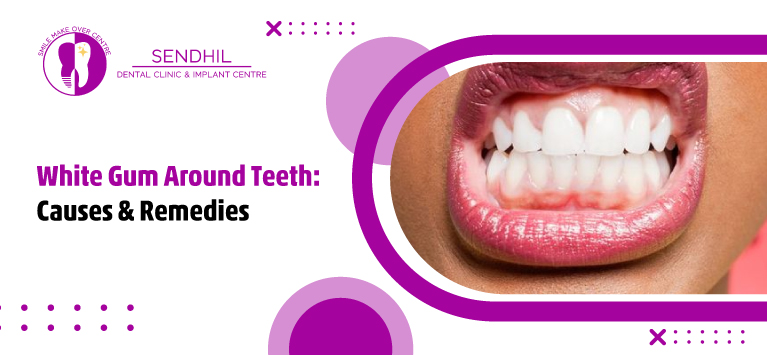
White Gum Around Teeth: Causes & Remedies
Have you ever questioned why the gums around your teeth are white? That might be your body telling you something has to be said! To assist you in comprehending the mystery of gum around the tooth being white, we will look into various potential explanations in this blog post, including gingivitis and allergic reactions. Don’t worry; we’ll also look at practical ways to tackle this issue naturally. As we dive right in, unravel the story your gums are attempting to tell you!
White gum around teeth
White gums around teeth can be a sign of several different illnesses. Therefore, seeing a dentist or other medical expert for a precise diagnosis and recommended course of action is crucial. The following list of possible reasons for white gums
Causes for white gum around teeth
- Gingivitis:
This can make the Gums around teeth white, especially along the gum line, and is a common cause of gum inflammation. If left untreated, gingivitis—which is frequently brought on by poor oral hygiene—can develop into more severe gum disease.
Causes: Inadequate dental hygiene is the leading cause of gingivitis, as it causes plaque to build up on teeth and gums. Toxins produced by bacteria found in plaque irritate and inflame the gums. Gingivitis can also result from hormonal changes (during menopause, puberty, or pregnancy), smoking, certain drugs, and systemic disorders like diabetes.
Symptoms: Gingivitis manifests as red, swollen, and sore gums; it can also cause bleeding gums, particularly during brushing or flossing; unpleasant breath or halitosis; and receding gums. Gingivitis may be minor and undetectable in the early stages, but symptoms become more noticeable as it worsens.
- Oral thrush:
This fungal infection, also called oral candidiasis, can result in white patches on the tongue, inside the cheeks, and gums around teeth. It is particularly prevalent in people using certain drugs, such as antibiotics, or in those with compromised immune systems, such as those with diabetes or HIV/AIDS.
Causes
Immune system weakness: HIV/AIDS, diabetes, and some drugs (such as steroids or antibiotics) can cause immune system weakness, which increases susceptibility.
Oral hygiene: An environment conducive to Candida growth can be produced by poor oral hygiene.
Dentures: Poorly fitting dentures may irritate the mouth or harbor bacteria, resulting in oral thrush.
Medical conditions: Some illnesses, such as xerostomia (dry mouth), may make you more vulnerable.
- Leukoplakia:
Due to this illness, white patches may appear on the tongue, inside the cheeks, or on the gums. It is frequently linked to tobacco usage, tooth abrasion, and dental appliances.
Appearance: Lesions from leukoplakia usually show as difficult-to-remove white or greyish spots. They can appear anywhere in the mouth, tongue, inner cheeks, the floor of the mouth, or Gums around teeth and might differ in size and shape.
Causes: Although the precise origin of leukoplakia is not always known, chronic mucous membrane irritation is frequently linked to the condition. Often irritating factors include:
- Chewing and smoking tobacco.
- Drinking alcohol.
- Having uneven teeth.
- Having dentures that fit poorly.
- Persistent friction from dental equipment.
Risk Factors: Risk factors for leukoplakia include using tobacco products (chewing or smoking), drinking a lot of alcohol, having teeth that are abrasive or dental appliances that cause discomfort over time, having a compromised immune system, and having specific viral infections like human papillomavirus (HPV).
- Oral lichen planus:
This long-term inflammatory disorder can impact the gums and other oral mucosal membranes. It may form white, lacy areas on the gums and other oral tissues.
Causes
Autoimmune response: Although the precise cause is unknown, an aberrant immune response is thought to be involved.
Genetics: The development of lichen planus may be genetically predisposed.
Triggers: Several things, including stress, specific drugs, and allergens, can cause or worsen symptoms.
Symptoms
the most typical symptom of oral lichen planus is the presence of white, lacy patches, frequently observed on the inside of the cheeks, tongue, gums, and lips.
Redness and swelling: The afflicted areas may have redness and swelling.
Ulcers: Painful sores or ulcers may appear occasionally.
Sensitivity: Consuming acidic or spicy meals may make you uncomfortable.
- Vitamin deficiencies
Vitamin deficits may also factor in gum health changes, resulting in abnormalities such as white spots. Gum health may be impacted by vitamin deficiencies, particularly those in vitamin C and vitamin K.
Scurvy, or vitamin C Deficiency: Scurvy is a condition brought on by a severe vitamin C deficiency. Gums that bleed and swell are among the symptoms; occasionally, they can seem pale or white. Insufficient vitamin C inhibits collagen synthesis, weakening the gums’ connective tissues.
Deficiency in Vitamin K: Vitamin K is essential for blood coagulation and bone metabolism, which includes maintaining jaw bone density. Vitamin K deficiency may impede the healing of wounds, including gum tissue, and may even be a factor in gum disease.
- Allergic reactions:
Certain meals, dental care items, or drugs may cause allergic reactions in some people, which can show up as white patches or gum edema.
Reactions Allergic to Oral Care Products: Certain people may have frequent allergies to substances in mouthwash, toothpaste, and dental materials. Allergy reactions can cause gum irritation, inflammation, or even color changes, such as white patches or spots.
Food Allergies: Severe food allergies can occasionally result in oral symptoms such as gum and mouth swelling, itching, or burning. It is less common for this to specifically manifest as white spots, but it can occasionally result in changes to the gums’ appearance.
Remedies for white gum around teeth
Maintain Good Oral Hygiene:
You should floss and brush your teeth at least twice daily to eliminate plaque and stop gum disease. Make use of a toothbrush with soft bristles and fluoride toothpaste.
Visit Your Dentist Regularly:
Gum is white around tooth disease, and other oral health problems can be prevented and treated with regular dental examinations and cleanings. In addition, your dentist can determine the cause of white gums and suggest the best course of action.
Address Gingivitis:
Your dentist might suggest professional teeth cleaning (scaling and root planning) to remove plaque and tartar accumulation if gingivitis is the reason for your white gums. To assist in the control of germs and inflammation, they could also recommend prescription toothpaste or antibiotic mouth rinses.
Treat Underlying Infections:
Your dentist may recommend antifungal or antibacterial drugs to treat oral thrush or any other fungal or bacterial infection causing white gums.
Address Irritation:
In cases where white gums are brought on by tobacco-related irritation, uneven teeth, or dental appliances, your dentist could advise against using tobacco products, taking care of any dental problems, including chipped teeth, or readjusting appliances to ensure a better fit.
Improve Nutrition:
Increasing your intake of vitamins and minerals and modifying your diet can assist if white gums result from vitamin deficiencies. Vitamin C-rich foods like bell peppers, strawberries, and citrus fruits can be beneficial.
Manage Allergies:
If white gums result from allergic reactions, find the allergen and stay away whenever possible. Your dentist or healthcare professional may also recommend antihistamines or other allergy drugs to assist in controlling symptoms.
Follow a Healthy Lifestyle:
Gum health and general oral health can also be enhanced by leading a healthy lifestyle, which includes eating a balanced diet, drinking plenty of water, abstaining from tobacco products, and controlling stress.
Conclusion:
You can now better care for your oral health because you know what causes white gums around your teeth and how to treat them. Recall that the best ways to keep your gums healthy and vibrant are to practice good oral hygiene, get regular dental exams, and care for any underlying problems. Cheers to a more radiant and robust smile!



